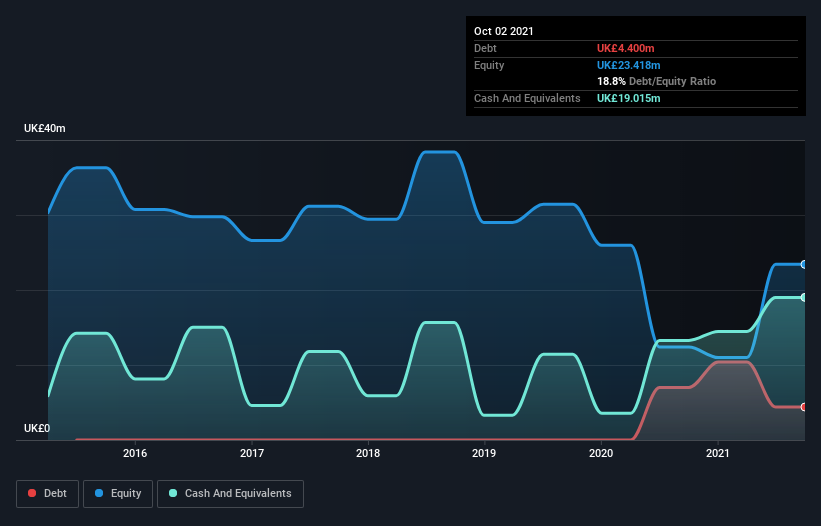Is Shoe Zone (LON:SHOE) Using Too Much Debt?
David Iben put it well when he said, 'Volatility is not a risk we care about. What we care about is avoiding the permanent loss of capital.' It's only natural to consider a company's balance sheet when you examine how risky it is, since debt is often involved when a business collapses. As with many other companies Shoe Zone plc (LON:SHOE) makes use of debt. But is this debt a concern to shareholders?
Why Does Debt Bring Risk?
Generally speaking, debt only becomes a real problem when a company can't easily pay it off, either by raising capital or with its own cash flow. Part and parcel of capitalism is the process of 'creative destruction' where failed businesses are mercilessly liquidated by their bankers. While that is not too common, we often do see indebted companies permanently diluting shareholders because lenders force them to raise capital at a distressed price. By replacing dilution, though, debt can be an extremely good tool for businesses that need capital to invest in growth at high rates of return. The first step when considering a company's debt levels is to consider its cash and debt together.
Check out our latest analysis for Shoe Zone
How Much Debt Does Shoe Zone Carry?
As you can see below, Shoe Zone had UK£4.40m of debt at October 2021, down from UK£7.00m a year prior. But it also has UK£19.0m in cash to offset that, meaning it has UK£14.6m net cash.
How Healthy Is Shoe Zone's Balance Sheet?
The latest balance sheet data shows that Shoe Zone had liabilities of UK£40.9m due within a year, and liabilities of UK£33.6m falling due after that. Offsetting this, it had UK£19.0m in cash and UK£5.46m in receivables that were due within 12 months. So its liabilities total UK£50.0m more than the combination of its cash and short-term receivables.
This is a mountain of leverage relative to its market capitalization of UK£70.0m. This suggests shareholders would be heavily diluted if the company needed to shore up its balance sheet in a hurry. Despite its noteworthy liabilities, Shoe Zone boasts net cash, so it's fair to say it does not have a heavy debt load!
Although Shoe Zone made a loss at the EBIT level, last year, it was also good to see that it generated UK£12m in EBIT over the last twelve months. The balance sheet is clearly the area to focus on when you are analysing debt. But ultimately the future profitability of the business will decide if Shoe Zone can strengthen its balance sheet over time. So if you want to see what the professionals think, you might find this free report on analyst profit forecasts to be interesting.
Finally, a company can only pay off debt with cold hard cash, not accounting profits. While Shoe Zone has net cash on its balance sheet, it's still worth taking a look at its ability to convert earnings before interest and tax (EBIT) to free cash flow, to help us understand how quickly it is building (or eroding) that cash balance. Happily for any shareholders, Shoe Zone actually produced more free cash flow than EBIT over the last year. That sort of strong cash conversion gets us as excited as the crowd when the beat drops at a Daft Punk concert.
Summing up
While Shoe Zone does have more liabilities than liquid assets, it also has net cash of UK£14.6m. And it impressed us with free cash flow of UK£29m, being 239% of its EBIT. So we don't have any problem with Shoe Zone's use of debt. The balance sheet is clearly the area to focus on when you are analysing debt. However, not all investment risk resides within the balance sheet - far from it. Be aware that Shoe Zone is showing 3 warning signs in our investment analysis , and 1 of those shouldn't be ignored...
If you're interested in investing in businesses that can grow profits without the burden of debt, then check out this free list of growing businesses that have net cash on the balance sheet.
Have feedback on this article? Concerned about the content? Get in touch with us directly. Alternatively, email editorial-team (at) simplywallst.com.
This article by Simply Wall St is general in nature. We provide commentary based on historical data and analyst forecasts only using an unbiased methodology and our articles are not intended to be financial advice. It does not constitute a recommendation to buy or sell any stock, and does not take account of your objectives, or your financial situation. We aim to bring you long-term focused analysis driven by fundamental data. Note that our analysis may not factor in the latest price-sensitive company announcements or qualitative material. Simply Wall St has no position in any stocks mentioned.

 Yahoo Finance
Yahoo Finance 
